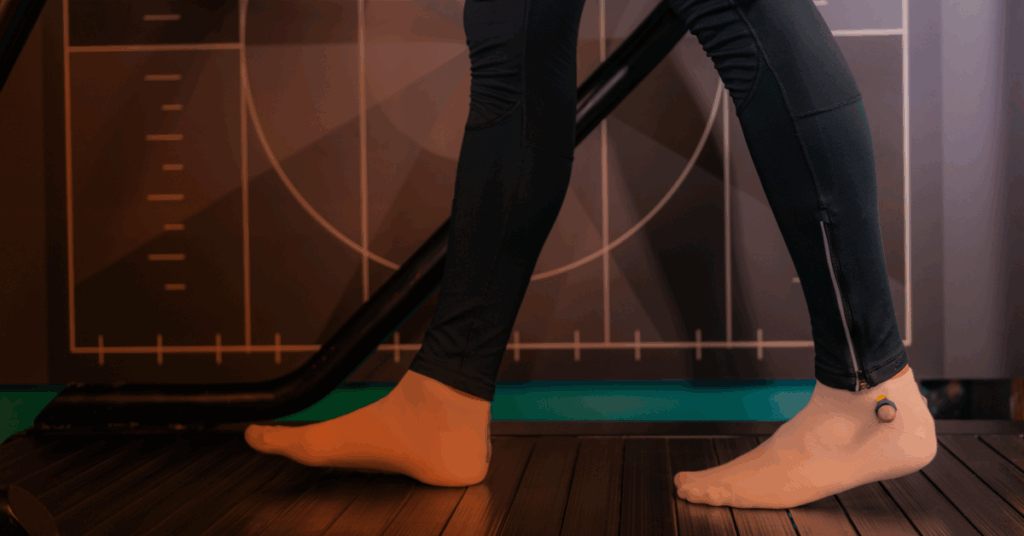Every step you take tells a story about your joint health. Your gait, or the way you walk, can have far-reaching effects on the rest of your body. Different types of gait can result in the utilization of different muscles, which can affect muscle growth, balance, and other factors.
Sometimes, injury or illness can lead to abnormal gaits. Walking this way can place new or additional strain on different parts of your body, potentially exacerbating injuries and pain.
Here, we’ll take a look at some different types of gait and how these walking patterns can affect your everyday life.
Understanding Common Gait Patterns
Your gait is the movement you undertake when you’re walking. In simple terms, it’s the pattern your feet follow when you place and lift them from the ground.
A strong gait keeps you balanced and distributes the impact across your joints, lessening the burden on one or two particular areas of the body. As we’ve seen, abnormal gait patterns can bypass this benefit and place stress on individual joints, causing faster wear and tear and eventually, injury.
A healthy gait distributes your bodyweight evenly and allows time for ligaments to extend and decompress naturally.
A regular gait pattern looks something like this:
1. Heel Strike (Initial Contact)
What happens: The heel makes first contact with the ground, marking the beginning of the stance phase.
2. Midstance (Loading Response & Single Support)
What happens: The full foot is flat on the ground, and all body weight is supported by this single leg.
3. Toe-Off (Terminal Stance & Pre-swing)
What happens: The heel lifts off the ground, and push-off begins through the toes.
4. Swing Phase
What happens: The entire foot is off the ground, swinging forward to prepare for the next heel strike.
A normal gait pattern is characterized by:
- Minimal energy expenditure
- Smooth, rhythmic movement
- Symmetrical left-right patterns
- Appropriate muscle activation timing
- Optimal joint range of motion utilization
Different types of gait can emerge for different reasons. The most common factor is age. As we age, our joints change, and we may no longer be able to keep up the healthy swing motion of a normal gait pattern. Other common causes for abnormal gaits include pre-existing health conditions or injuries. Lastly, some people may have just always walked that way and do so as a force of habit.
Common Types of Abnormal Gait
Though abnormal gaits are entirely normal and a common occurrence, they can lead to injuries or long-term health disadvantages. If it’s possible to do so, those with this gait pattern should try to improve their walking pattern.
It can be hard to undo a life of walking in a certain way. However, as with many habits, it is possible to change the way we walk with time and effort. After a period of diligent practice, you’ll find yourself walking with a regular gait pattern without even having to think about it.
But, just what is an abnormal gait pattern? And how do you know if you have one? Let’s take a look at some of the most common.
1. Antalgic Gait (Limping to Avoid Pain)
What it looks like:
- Walking with a noticeable limp
- Taking quick, short steps on the painful leg
- Spending as little time as possible on the sore foot or leg
- Leaning away from the painful side
What causes it:
- Recent injuries: Broken bones, bad sprains, pulled muscles
- Ongoing problems: Arthritis, worn-out joints, chronic pain
- Foot problems: Plantar fasciitis, heel spurs, ingrown toenails
- After surgery: Hip or knee replacement recovery
With an antalgic gait, your good leg works overtime carrying most of your body weight. Plus, your back and hips can tighten as you naturally lean to one side.
2. Trendelenburg Gait (Hip Drop Walk)
What it looks like:
- One side of your pelvis drops down with each step
- You lean your whole body toward the leg you’re standing on
- It looks like you’re “waddling” when you walk
- Your hips seem uneven when walking
What causes it:
- Weak hip muscles: The muscles that keep your pelvis level aren’t working right
- Nerve problems: Damage to nerves that control hip muscles
- Hip problems: Born with hip issues or damaged hips
- After hip surgery: Muscles may be weakened during the procedure
Hip drop walks place further strain on your lower back, knees, and ankles. This additional weight causes pain and, in the long term, can lead to arthritis from rapid joint wear and tear.
3. Steppage Gait (High-Stepping Walk)
What it looks like:
- Lifting your knee extra high to clear the ground
- Your foot slaps down hard when it lands
- Walking like you’re marching or stepping over invisible obstacles
- Usually affects just one leg
What causes it:
- Nerve damage: Nerves that lift your foot aren’t working
- Muscle weakness: Muscles in your shins are too weak
- After injuries: Severe leg injuries that damaged muscles or nerves
- Medical conditions: Stroke, pinched nerves in your back
Here, your hips work overtime lifting your legs higher. This type of abnormal gait places undue strain on the hip joints, leading to tightness and soreness.
4. Stiff Gait (Jerky Walk)
What it looks like:
- Very stiff, robot-like movements
- Legs may cross over each other when walking
- Walking on tiptoes or with a very stiff ankle
- Jerky, uncontrolled movements
What causes it:
- Brain or spinal cord damage: From stroke, cerebral palsy, or injuries
- Neurological diseases: Multiple sclerosis, brain injuries
- Birth conditions: Problems present from birth affecting movement
- Spinal cord injuries: Incomplete damage that affects muscle control
A stiff gait keeps muscles tight, limiting movement and preventing the muscles and ligaments from ever relaxing.
Joint Health Consequences of Gait Abnormalities
Think of your body as a stack of building blocks. When you walk normally, forces travel up through your body like a gentle wave – from your foot, to your ankle, to your knee, to your hip, and up to your spine. Each joint absorbs some of the impact and passes the rest along smoothly.
But when you walk abnormally, it’s like one building block is crooked. This forces all the blocks above it to lean and shift to stay balanced. Over time, this puts stress on joints that were never meant to handle those forces. This chain reaction can have a compounding effect.
Abnormal types of gait can cause problems that may eventually wreak havoc on your joints.
Here’s where joint problems most commonly arise:
The Knee Takes the Brunt
- Poor alignment from above or below puts sideways stress on the knee
- Uneven weight distribution wears out cartilage faster on one side
- Compensatory movements overwork the muscles around the kneecap
Hip Problems Multiply
- Overworked hip muscles become tight and painful
- Uneven forces accelerate hip joint wear
- Poor hip function affects everything above and below
Your Spine Pays the Price
- Compensatory curves develop to maintain balance
- Back muscles work overtime and become chronically tight
- Disc pressure increases from poor alignment
The Foot and Ankle Connection
- Your foot hits the ground wrong – instead of a smooth heel-to-toe roll, you might land too hard on one spot
- Your ankle has to work overtime – compensating for poor foot placement
- Common results: Plantar fasciitis, ankle arthritis, Achilles tendon problems
Injury and stress across these joints can lead to pain, tightness, and, in the long term, conditions like arthritis and lasting back pain.
Diagnosis and Assessment at NYBJ
When you come to New York Bone & Joint Specialists, worried about how you’re walking, we don’t just guess what’s wrong. We use advanced technology and proven methods to get to the root of the problem.
The process is straightforward:
- You walk normally while we observe and measure
- We identify the problem areas using specialized equipment
- We create a personalized treatment plan based on what we find
- We work together to get you walking properly again
Our comprehensive evaluation includes motion analysis that tracks every movement while you walk, pressure mapping to show how your feet contact the ground, and muscle activity testing to identify timing problems.
The assessment takes a little over an hour and is completely painless. You’ll walk on specialized equipment while sensors capture detailed data about your movement patterns. Our team of orthopedic specialists, physical therapists, and injury experts works together to analyze your results.
What makes us different is our technology-driven approach combined with personalized care. We don’t just treat symptoms – we identify root causes. Most patients receive preliminary results the same day, with a detailed treatment plan within a few days.
Treatment Solutions and Orthopedic Interventions
We fix walking problems using a progressive approach, starting with the gentlest effective treatments first.
Conservative treatments work for most patients with minor gait adjustments and include physical therapy (6-12 weeks of targeted exercises), gait training (relearning proper walking patterns), and orthopedic shoes or custom orthotics that correct foot alignment and redistribute pressure.
Advanced interventions are reserved for severe cases. Surgical options include tendon repairs (85-90% success rate), joint realignment procedures, and nerve decompression. Modern joint replacement offers 95% success rates for hip problems and 90% for knee issues, with most patients walking within days of surgery.
Our treatment philosophy prioritizes function over just pain relief. We personalize every plan based on your age, activity level, and goals. Whether you need simple orthotics or complex surgery, our goal is to get you back to the activities you love while preventing future joint damage.
Prevention and Early Intervention
Preventing walking problems is far easier and cheaper than treating them after they develop. The key is recognizing warning signs early and taking action within the first 6 weeks when problems are most easily corrected.
Red flag symptoms requiring immediate attention include persistent limping, pain that changes your walking pattern, unusual shoe wear patterns, or family members noticing changes in how you move. Energy changes like getting tired more easily or avoiding activities you used to enjoy are often early signs that people ignore.
Prevention strategies include regular strength and balance exercises, proper footwear (replaced every 300-500 miles), weight management (every extra pound puts 4 pounds of pressure on knees), and annual walking assessments for those over 50.
Age-specific prevention varies: young adults should address sports injuries promptly, middle-aged adults need strength training as metabolism slows, and older adults require fall prevention and balance training.
Start your recovery journey
Your walking health affects every aspect of your life. Small walking problems become big joint problems, but early action can prevent years of pain and expensive treatments.
Come in and see our specialists today and begin your journey towards a healthy gait pattern.
Don’t wait for problems to worsen. Schedule your walking health assessment today.




